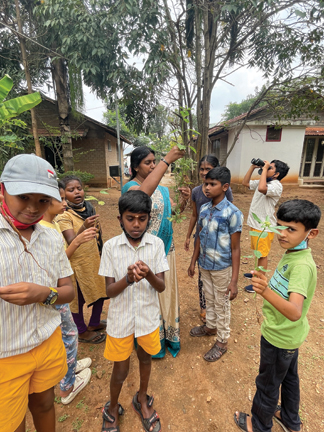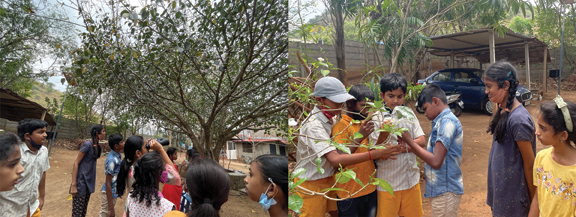Prema Rangachary
A group of class 3 and class 4 students went on a nature walk to collect stones, leaves and twigs for their science class. Some students did not just pick up the stones but examined what was underneath. As they dug deeper and saw ants, bugs and worms, they were fascinated. A volley of excited questions ensued: How do creatures that live underground breathe? Why are some roots below the soil and some above? Why do dry leaves have holes in them? Why do some leaves have colours other than green? How do these leaves make food without the green colour?

As they tried to relate what they had heard in the classroom to their real-life experience, the primary class came alive. How does a teacher address such curious children? Does the method cater to different styles of learning and individual capacities without dampening one’s curiosity and enthusiasm? This is the challenge of the primary teacher.
A primary education programme has a greater responsibility than just teaching language and computational skills. No doubt these are necessary for children to meet the demands of secondary schooling, but the primary section has a greater role of providing a broad-based learning that includes the development of social, cognitive, emotional and physical skills. The main objectives are to enjoy learning and to ensure a desire to learn, to develop self-learning abilities, critical thinking and logical judgments. This is the first step in helping a child’s personality evolve and is an important bridge between kindergarten and secondary education.
Primary learners are different and varied in their abilities, and therefore find it difficult to adjust to a one-size-fits-all environment. They need differentiation in order to receive and retain information presented by the teacher. How can this be achieved?
- By adapting the content to suit the students’ interest and language proficiency levels.
- By encouraging peer and group leaning along with individualized learning.
- By receiving and expressing the learning in different forms as art, music, dance, drama, poetry or speech.
- By providing a fear-free and safe environment for students to feel accepted and allowed to make mistakes and give positive feedback.
To encompass all this, a theme-based model of learning seems the most appropriate to teach science in primary school. This model allows one to learn many skills along with the content when integrated with the curriculum. This extension of a topic to different disciplines makes learning meaningful as it allows learners to perceive the seamless connection between subjects. This method of teaching links the different strands of the curriculum, focuses on the children’s interests and creates a sense of purpose and feeling of community in the classroom. Knowledge is built by including the children’s interests and life experiences in the learning process. Inquiry and communication are stimulated, resulting in active participation.
The integrated studies approach calls for a collaborative working model among teachers as well. A single teacher does not have sole control of the curriculum and the sole control of the curriculum is no longer with the single teacher in this approach. This model can be implemented by many teachers planning together, but remains flexible, allowing student interest to lead the unit in different directions. As a result, the more the students become involved in how and what they study, the more interested they become in learning.
How it works
- Choose a theme. The first task is to discuss and define a theme that will form the basis of a unit of study. Goal(s) pertaining to the theme (i.e., not specific to curriculum areas) should be agreed upon by the planning team.
- Plan ahead. Develop a realistic plan around the chosen theme. Decide who will plan specific curriculum areas and set a date for completion. Plan the entire unit together and ensure that specific objectives are met. Tasks that should be completed before you begin teaching include: setting objectives (for curriculum areas), determining evaluation strategies, dividing planning responsibilities, setting deadlines for completion of planning, gathering/locating resources for the whole class, devising a final activity to end the project. Reach out to the community for assistance. Map the entire unit using weekly planning.
- Put the plan into action. Introduce the theme. You will need to be flexible as student ideas and interests may take you in unexpected directions. Continue to meet with the planning team for inspiration and support as the unit progresses and adjust the plan according to the situation.
- Evaluate. Evaluate the students’ progress with tools that reflect the objectives in step 2. When you have completed the activities, evaluate the success of the unit, share information with other classes, parents and community groups.
Soil as an example
Children love to play with soil, and its immediacy makes it an interesting subject. The theme lends itself to a detailed study of science, social science, maths and the languages. In our school, we began with the symbol of the pot. Pottery was one work outcome of the theme. A pot is also the symbol of the five elements: Earth is mixed with water to make clay, which is baked in the kiln (fire) and encompasses air and is sustained in space. We then proceeded to studying the creatures in the soil and moved on to the plant and animal kingdom, which includes the human being. The full circle connected with ecology, environment and pollution, leading back to the soil. The theme can thus be extrapolated to every class level.

Science: Characteristics of soil (colour, texture), nutrients and fertility, process of soil formation, factors responsible for different kinds of soil like climate, rainfall, water, etc.
Mathematics: Shapes (of things made from earth like bricks, pots), area and perimeters, fractions via proportion of nutrients, measurements like volume and weight (for instance, when digging a pit to plant a coconut sapling, what was the weight and volume of the excavated soil?)
Social science: Ecosystems, vegetation and wildlife, major landforms, environmental conservation, atmosphere, topography, archaeology.
Fine arts: Painting, pottery, clay modelling, murals, sculpture.
Language: Stories, literature, essays, poems, slogans, debates.
Let me now present a detailed exposition on how a single theme can be presented for science.
Theme: Plants (with a focus on science learning)
Level 1
In Level 1, topics are connected to the community workers like the gardener or the farmer. So through the activities of the community workers, we introduce plants. The gardener takes care of trees like mango, shrubs like hibiscus, plants like sunflower and lilies in the pond. These are the varieties introduced in the garden. The farmer on the other hand cultivates food grains like rice, wheat and millets on a large scale.
Level 2
- Classification of plants 2. Parts of a plant 3. Importance of plants 4. Flowering and non-flowering plants 5. Germination. 6. Uses of plants.
Activities: 1. Brainstorming about plant life. 2. Nature walk to show different types of plants and to identify flowering and non-flowering plants. 3. Importance of soil for plant growth.
Experiments: Germination; leaf is the kitchen of the plant. Introducing the idea of photosynthesis.

Level 3
- Root system 2. Shoot system 3. Functions of the parts of the plant 4. Photosynthesis 5. Differences between plant and animal life 6. Edible and non-edible crops. 7. Planning a kitchen garden.
Activities:
1. Establish the functions of the root. Experiment: How roots prevent soil erosion.
- Function of stem. Experiment: Stem conducts water to the different parts of the plant.
- Function of the leaf. Experiment: How glucose, oxygen and water are produced during photosynthesis.
Level 4
- Differences between plants and animals 2. Photosynthesis 3. Types of roots 4. Plant habitats and adaptation 5. Plants as source of food 6. Flower and its parts 7. Climatic conditions needed for plant growth 8. Importance of forest. 9. From fibre to fabric.
Activities: 1. Leaf as the kitchen of the plant. Experiments to show the importance of air, water, sunlight and chlorophyll in producing starch. 2. Experiments to show the similarities and dissimilarities between plants and animals. 3. Experiments to show the structure of the two-root system and its advantages.
Level 5
- Parts of a plant 2. Fruits and seeds 3. Seed dispersal 4. Seed shapes
Activities: 1. Field trip to find, collect and identify seeds and the different seed dispersal methods; parts of the plant and modifications that help seed dispersal by air, water and animals 2. Kinds of fruits. Classification according to colour, taste, size and shape. 3. Grown on trees, plants or creepers and shrubs 4. Edible and non-edible fruits. 5. Making charts on these features. Making fruit salad.
In Level 4 and 5, maths and social science may overlap. Consider plant adaptations to different habitats and climatic conditions. For example, desert plants, high-altitude plants, aquatic plants, those that grow in marshy lands… all this will cover the study of landforms. The discussions can also include importance of forests, deforestation and afforestation and the need to preserve forests and soil pollution due to chemical fertilizers.
Maths can involve symmetry of leaf arrangements, an estimation of the height of a tree, measurement of the shadow, area of the leaf.
While English is the connecting link for all these subjects, we can also choose poems and stories connected to the theme for the language class. For example, an extract from The Lord of the Rings, which discusses where food comes from can be used as a speaking exercise. For writing, children could be asked to imagine the story of a banyan tree.
Thus, theme-based learning helps children to make more sense of their lived reality and apply acquired scientific knowledge. However, this pedagogical concept tests teachers’ resolve, application and resourcefulness. It requires sensitive teachers who also need to educate parents and the community about the desirability of this enlightened and democratic teaching-learning process.
The author is founder and director of Vidya Vanam, a school for tribal and underprivileged children in Anaikatti, Nilgiris, Coimbatore. She can be reached at rangacharyprema@gmail.com.
